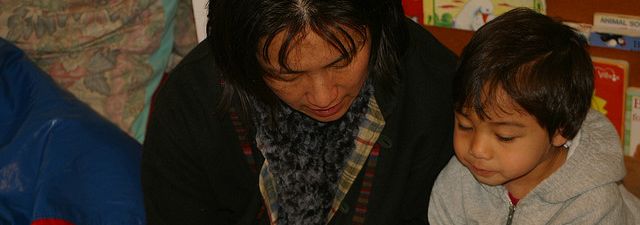Preschool English Learners, Their Families, and Their Communities
Professional Development Session
Format: Mixed model, 2 hour interactive session; Prior to the session: read selected state publication pages, articles, PowerPoint and handouts. In addition view Developing the Young Bilingual Learner on streaming video. During the session, participants will engage in activities to identify the roles of families in first and second language acquisition and articulate strategies for connect home and school language and literacy practices.
English learners form a substantial and growing segment of the preschool population in California. During the 2006-2007school year, approximately 42 percent of California’s kindergartners were identified as English learners. Recent estimates indicate that about 39 percent of three to five year olds are English learners, and in some counties that percentage may be more than 50 percent. The education of children who are English learners is enhanced when preschool programs form meaningful relationships with families. Through these relationships, teachers create a bridge between home and school language and literacy practices (PCF, pp.178-179, 180). Prior to the session, participants read selections from state publications, access and read the articles and handouts, and view the PowerPoints and streaming video presentations. During the interactive session, participants will discuss the roles of families and immigration in young English learners’ language and literacy development (PCF, p. 178).
Resources
 | State PublicationsPreschool English Learners: Principles and Practices to Promote Language, Literacy and Learning, Chapters 2 and 6 |
 | Chapters and ArticlesBang, Y.-S. 2009. Family Ties. Helping all families participate in school life. Young Children. How to Reach out to Parents of ELLs. 2007. Tabors, P.O. 2008. One child, two languages: A guide for early childhood educators of children learning English as a second language. Baltimore, MD: Brookes. Vesely, C.K., & Ginsberg, M.R. January, 2011. Strategies and practices for working with immigrant families in early education programs. Young Children. |
 | Powerpoints
|
 | HandoutsBecoming a Reader (PEL Guide Training, Chapter 8, HO p. 4) Dual Language Learners in Early Care and Education Settings. ZERO TO THREE. Key Demographics and Practice Recommendations for Young English Learners. The National Clearinghouse for English Language Acquisition & Language Instruction Educational Programs. The Growing Number of English Learner Students. The National Clearinghouse for English Language Acquisition & Language Instruction Educational Program. Identifying the Early Literacy Skills Found in Songs, Books, and Rhymes Used by Families (PEL Guide Training, Chapter 8, HO p. 3) Survey of Children’s Home Literacy Activities (PEL Guide Training, Chapter 8, HO pp. 2-3)
|
 | VideoDeveloping the Young Bilingual Learner (NAEYC 1998)—video from PEL Guide training
|

